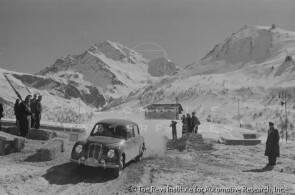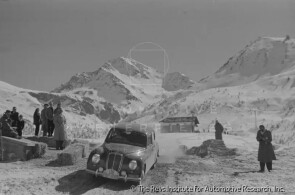
1953 Lancia Aurelia B22 Berlina
ON/OFF
Why am I an Automotive Masterpiece?
The post-war period brought a desire, a hunger for renewal. People wanted to forget and surpass Everything that reminded of the past and the time before the war. Cars were the "first" example of this thirst for novelty. Since its appearance, the Aurelia caused quite a stir, mainly because, together with the contemporary Fiat 1400, it represented the first genuinely new "Italian" automotive product of the post-war period. The first Lancia car of the post-war period, the revolutionary Aurelia designed by Vittorio Jano appeared in 1950. At the Salone di Torino, inaugurated on May 4, 1950, was exhibited the first of all the Aurelia cars, the B10 sedan, featuring a harmoniously rounded line. It boasted a series of revolutionary innovations on the technical level. To mention a few: the first V-6 engine with a V of 60° as standard 1.8 litres, developed by Francesco de Virgilio, the monocoque with independent four-wheel suspension, the new gearbox/differential unit mounted in a transaxle layout, and inboard rear brakes. The bodywork was partly made of aluminium with the windshield and rear window in curved glass. In the Aurelia, especially in this first B10 version, the qualities of comfort, luxury and ride flexibility were favoured. A year later, in the spring of 1951, arrived an engine with a displacement of 2 litres, mounted on the new B20 coupe and, as an alternative to the 1.8 litres, on the sedan that takes the name of B21. The range of the "first series" Aurelia expanded further at the beginning of autumn 1952 when appeared a new lengthened limousine with 6-7 seats, the B15 type and a new version of the sedan is added to the B10 and B21, the B22 model.
The Aurelia B22 was also designed to participate in the races in the turismo category; a "two liters" (like the B21) greatly enhanced: 90 hp in the standard version on the market. The creation of this model of sports tuned sedan comes on the spur of the sporting successes obtained by the Aurelia B20 and B21 in 1951 and early 1952, successes that however are seriously endangered by the looming rival Alfa Romeo 1900, especially tough in its latest version TI (Turismo Internazionale). Born with competitive intent, the B22 harmonizes very well a sober, elegant, almost luxurious car body, with a power unit with significant performance (the maximum speed exceeds 160 km/h). The competitive career of the B22, which seems to be able to oppose Alfa Romeo with some effectiveness, was interrupted however in 1953, when a diatribe arose with the Milanese factory and with the Italian Automobile Sports Commission (CSAI) regarding the validity of homologation: for a few months, the CSAI inhibits the participation in the races in the Turismo category to both the Lancia B22 and the Alfa TI and, at the end, Gianni Lancia decides to suspend the direct participation of the House in this category and in 1954 presents the second series of Aurelia, unified, less sporty and, above all, equipped with an engine of almost 2300 cc which effectively precludes the car from participating in speed races. As a curiosity and to understand the spirit of the car: in this first series of Aurelia the proportion of cars required with the right hand drive is nine to one compared to those with left hand drive. A slightly snobby and somewhat sporting spirit prevailed over mere practicality, unquestionably.
Lancia Aurelia B22, chassis no. B22-1263, engine no. 1379, is a 1953 model. It is finished in gray livery with typical woolen Lancia gray cloth interiors. It is one of 3 cars built in 1953 and registered in Torino (with plate TO142841), together with the chassis no. B22-1142 and B22-1266 plated TO142842 and TO142845. The car was first registered to the Scuderia Lancia s.r.l., so that the car was actually a Works car. Chassis no. B22-1263 participated to the 1953 Rally del Sestrière with Christillin – Fiorio at the wheel and to the 1954 Rally del Sestrière with Giletti - Cinti. Emilio Christillin was an industrialist, president of the Automobile Club Torino from 1970 to 2001, Sandro Fiorio was a leather businessman, who later ran the Lancia public relations department. He’s the father of the famed Cesare Fiorio and grandfather of Alex Fiorio. Emilio Giletti, now the owner of Giletti S.p.A., is the father of the anchorman Massimo Giletti. Recently the car participated to several re-enactments, such as the Coppa d’Oro delle Dolomiti in 1987. In addition, it participated to the 2017 Mille Miglia.





